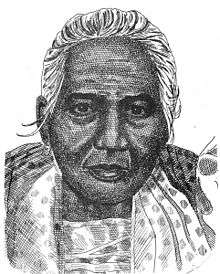Melchora Aquino
Melchora Aquino de Ramos (6 January 1812 – 19 February 1919) was a Filipina revolutionary who became known as "Tandang Sora" ("Elder Sora") because of her age during the Philippine Revolution.
Melchora Aquino de Ramos | |
|---|---|
 | |
| Born | Melchora Aquino January 6, 1812 |
| Died | February 19, 1919 (aged 107) |
| Nationality | Filipino |
| Other names | Tandang Sorâ |
| Spouse(s) | Fulgencio Ramos |
| Children | 7 |

She was known as the "Grand Woman of the Revolution" and the "Mother of Balintawak" for her contributions.
Early life and marriage
Aquino was born on 6 January 1812 in Balintawak, Quezon City.[1]
Aquino, daughter of a peasant couple, Juan and Valentina Aquino, never attended school. However, she was apparently literate at an early age and talented as a singer and performed at local events as well as at Mass for her Church. She was also often chosen for the role of Reyna Elena during the "Santacruzan", a processional pageant commemorating Empress Helen's finding of the Cross of Christ, celebrated in the Philippines in May.[1][2]
Later in life, she married Fulgencio Ramos,[1] a cabeza de barrio (village chief), and bore six children. Ramos died when their youngest child was seven and she was left as a single parent for their children. Aquino continued her life as an hermana mayor active in celebrating fiestas, baptisms, and weddings. She worked hard in order to give her children an education.[1]
Involvement in the revolution
In her native town, Tandang Sora operated a store,[3] which became a refuge for the sick and wounded revolutionaries. She fed,[1] gave medical attention to and encouraged the revolutionaries with motherly advice and prayers.
Secret meetings of the Katipuneros (revolutionaries) were also held at her house. Thus she earned the names "Woman of Revolution", "Mother of Balintawak", "Mother of the Philippine Revolution", and Tandang Sora (Tandang is derived from the Tagalog word matandâ, which means old). She and her son, Juan Ramon, were present in the Cry of Balintawak and were witnesses to the tearing up of the cedulas.[1]
When the Spaniards learned about her activities and her knowledge to the whereabouts of the Katipuneros, she was interrogated but she refused to divulge any information. She was then arrested by the guardia civil and was deported to Guam, Marianas Islands,[1] where she and a woman named Segunda Puentes were placed under house arrest in the residence of a Don Justo Dungca.[4][5]
After the United States took control of the Philippines in 1898, Tandang Sora, like other exiles, returned to the Philippines until her death on 19 February 1919, at the age of 107.[1] Her remains were then transferred to her own backyard (now known as Himlayang Pilipino Memorial Park, Quezon City).

Legacy
As a token of gratitude, a Quezon City district and a road were named after Aquino. Her profile was also placed in the Philippines' five-centavo coin from 1967-92.
She was the first Filipina who appears on a Philippine peso banknote, in this case, a 100-peso bill from the English Series (1951–66). Tandang Sora Street in the city of San Francisco, California, United States, is named in her honor.
In 2012, on the celebration of her 200th birthday, the City Government of Quezon City decided to transfer Aquino's remains from Himlayang Pilipino Memorial Park to the Tandang Sora National Shrine in Banlat, Quezon City. The city government also declared 2012 to be Tandang Sora Year.[6][7]
Her descendants carry different surnames, with almost all living in Novaliches and Tandang Sora districts in Quezon City as well as in Guam (USA) such as Figueroa, Ramos (her husband’s surname), Geronimo, Eugenio, Cleofas and Apo.[8]
In popular culture
- Portrayed by Angelita Loresco in the 2013 TV series Katipunan.
- Portrayed by Erlinda Villalobos in the 2014 film Bonifacio: Ang Unang Pangulo.
- Referenced in the song “Babae” By Inang Laya
References
- Language Arts for the Filipino Learners: An Integrated Language and Reading Work-a-Text for Grade Four: Volume One. Rex Bookstore, Inc. pp. 106–. ISBN 978-971-23-1402-5.
- "5 Surprising Facts About Melchora Aquino ('Tandang Sora')". 19 March 2014.
- Kirstin Olsen, ed. (1994). Chronology of women's history. Greenwood Publishing Group. p. 207. ISBN 9780313288036.
- Augusto V. de Viana, "In the Far Islands,: The Role of Natives from the Philippinees in the Conquest, Colonization and Repopulation of the Mariana Islands. 2004:134.
- Isagani R. Medina, "Melchora Aquino Wife of Fulgencio Ramos," In: Women in the Philippine Revolution, Rafaelita Hilario Soriano, ed. Quezon City: Printon Press, 1995, pp 12-13.
- "P-Noy to lead re-interment of Tandang Sora's remains". Worldcoingallery.com.
- Ocampo, Ambeth. "Tandang Sora home on her 200th birthday". Philippine Daily Inquirer. Retrieved 2012-01-08.
- INQUIRER.net. "Heirs want Tandang Sora holiday declared". newsinfo.inquirer.net. Retrieved 2015-09-04.
| Wikimedia Commons has media related to Melchora Aquino. |